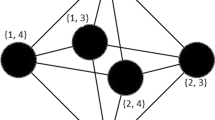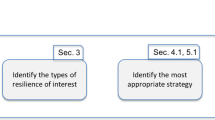Abstract
Coherent systems, i.e., multicomponent systems where every component monotonically affects the working state or failure of the whole system, are among the main objects of study in reliability analysis. Consider a coherent system with possibly dependent components having lifetime T, and assume we know that it failed before a given time \(t>0\). Its inactivity time \(t-T\) can be evaluated under different conditional events. In fact, one might just know that the system has failed and then consider the inactivity time \((t-T|T\le t)\), or one may also know which ones of the components have failed before time t, and then consider the corresponding system’s inactivity time under this condition. For all these cases, we obtain a representation of the reliability function of system inactivity time based on the recently defined notion of distortion functions. Making use of these representations, new stochastic comparison results for inactivity times of systems under the different conditional events are provided. These results can also be applied to order statistics which can be seen as particular cases of coherent systems (k-out-of-n systems, i.e., systems which work when at least k of their n components work).


Similar content being viewed by others
References
Barlow RE, Proschan F (1975) Statistical theory of reliability and life testing. Probability models., International series in decision processes. Holt, Rinehart and Winston Inc, New York
Bassan B, Spizzichino F (2005) Relations among univariate aging, bivariate aging and dependence for exchangeable lifetimes. J Multiv Anal 93:313–339
Colangelo A, Scarsini M, Shaked M (2005) Some notions of multivariate positive dependence. Insur Math Econ 37:13–26
Durante F, Saminger-Platz S, Sarkoci P (2008) On representations of 2-increasing binary aggregation functions. Inform Sci 178:4534–4541
Durante F, Sempi C (2015) Principles of copula theory. CRC/Chapman & Hall, London
Fang Z, Hu T (1997) Developments on \(\text{ MTP }_{2}\) properties of absolute value multinormal variables with nonzero means. Acta Math Appl Sin 13:376–384
Goli S, Asadi M (2017) A study on the conditional inactivity time of coherent systems. Metrika 80:227–241
Grabisch M, Marichal JL, Mesiar R, Pap E (2009) Aggregation functions. Cambridge University Press, Cambridge
Karlin S, Rinott Y (1980) Classes of orderings of measures and related correlation inequalities. I. Multivariate totally positive distributions. J Multiv Anal 10:467–498
Kuo W, Zhu X (2012) Importance measures in reliability, risk, and optimization: principles and applications. Wiley, Chichester, UK
Li X, Lu J (2003) Stochastic comparisons on residual life and inactivity time of series and parallel systems. Probab Eng Inf Sci 17:267–275
Li X, Pellerey F, You Y (2013) On used systems and systems with used components. Stochastic orders in reliability and risk. In: Honor of Professor Moshe Shaked. Springer, New York, pp 219–233
Navarro J (2016a) Stochastic comparisons of generalized mixtures and coherent systems. TEST 25:150–169
Navarro J (2016b) Distribution-free comparisons of residual lifetimes of coherent systems based on copula properties. To appear in Stat Papers. doi:10.1007/s00362-016-0789-0 (published online first June 2016)
Navarro J, Durante F (2017) Copula-based representations for the reliability of the residual lifetimes of coherent systems with dependent components. J Multivar Anal. doi:10.1016/j.jmva.2017.04.003 (published online first April 2016)
Navarro J, del Aguila Y, Sordo MA, Suarez-Llorens A (2013) Stochastic ordering properties for systems with dependent identically distributed components. Appl Stoch Models Bus Ind 29:264–278
Navarro J, del Aguila Y, Sordo MA, Suarez-Llorens A (2014) Preservation of reliability classes under the formation of coherent systems. Appl Stoch Models Bus Ind 30:444–454
Navarro J, del Aguila Y, Sordo MA, Suarez-Llorens A (2016) Preservation of stochastic orders under the formation of generalized distorted distributions. Applications to coherent systems. Methodol Comput Appl Probab 18:529–545
Navarro J, Gomis MC (2016) Comparisons in the mean residual life order of coherent systems with identically distributed components. Appl Stoch Models Bus Ind 32:33–47
Navarro J, Pellerey F, Di Crescenzo A (2015) Orderings of coherent systems with randomized dependent components. Eur J Oper Res 240:127–139
Navarro J, Rychlik T (2010) Comparisons and bounds for expected lifetimes of reliability systems. Eur J Oper Res 207:309–317
Navarro J, Samaniego FJ, Balakrishnan N (2011) Signature-based representations for the reliability of systems with heterogeneous components. J Appl Probab 48:856–867
Navarro J, Spizzichino F (2010) Comparisons of series and parallel systems with components sharing the same copula. Appl Stoch Models Bus Ind 26:775–791
Nelsen RB (2006) An introduction to copulas, 2nd edn., Springer series in statistics. Springer, New York
Pellerey F, Petakos K (2002) On the closure of the NBUC class under the formation of parallel systems. IEEE Trans Reliab 51:452–454
Samaniego FJ, Navarro J (2016) On comparing coherent systems with heterogeneous components. Adv Appl Probab 48:88–111
Shaked M, Shanthikumar JG (2007) Stochastic orders., Springer series in statistics. Springer, New York
Zhang Z (2010) Mixture representations of inactivity times of conditional coherent systems and their applications. J Appl Probab 47:876–885
Zhang Z, Balakrishnan N (2016) Representations of the inactivity time for coherent systems with heterogeneous components and some ordered properties. Metrika 79:113–126
Acknowledgements
We sincerely thanks the editors and referees for their careful reading of the manuscript and for their thoughtful comments and suggestions that greatly improved the presentation of the paper. JN is partially supported by Ministerio de Economía y Competitividad under Grant MTM2012-34023-FEDER. FP and ML are partially supported, respectively, by the Italian GNAMPA and GNCS research groups of INdAM (Istituto Nazionale Di Alta Matematica).
Author information
Authors and Affiliations
Corresponding author
Rights and permissions
About this article
Cite this article
Navarro, J., Longobardi, M. & Pellerey, F. Comparison results for inactivity times of k-out-of-n and general coherent systems with dependent components. TEST 26, 822–846 (2017). https://doi.org/10.1007/s11749-017-0535-5
Received:
Accepted:
Published:
Issue Date:
DOI: https://doi.org/10.1007/s11749-017-0535-5




